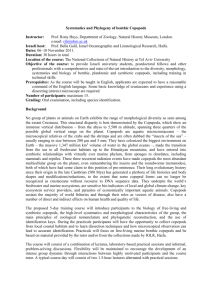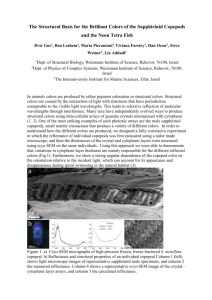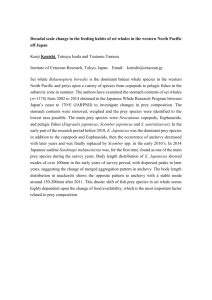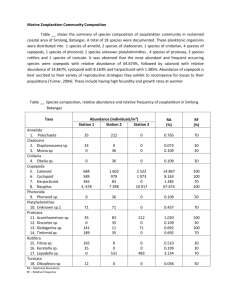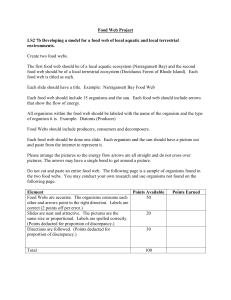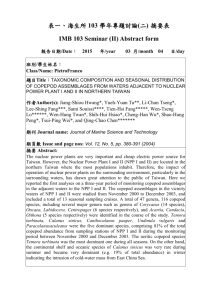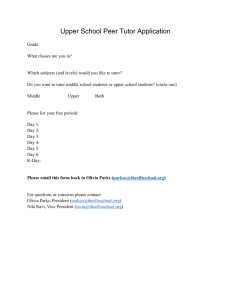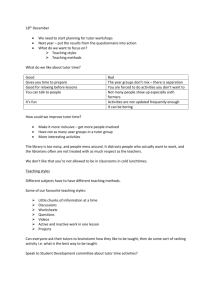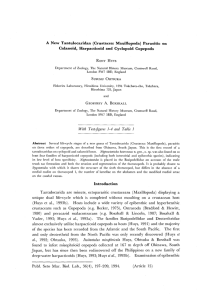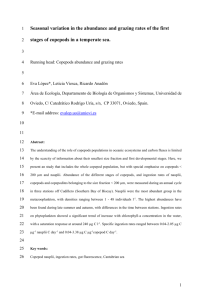Training Workshop on Morphology and Systematics of Copepods
advertisement
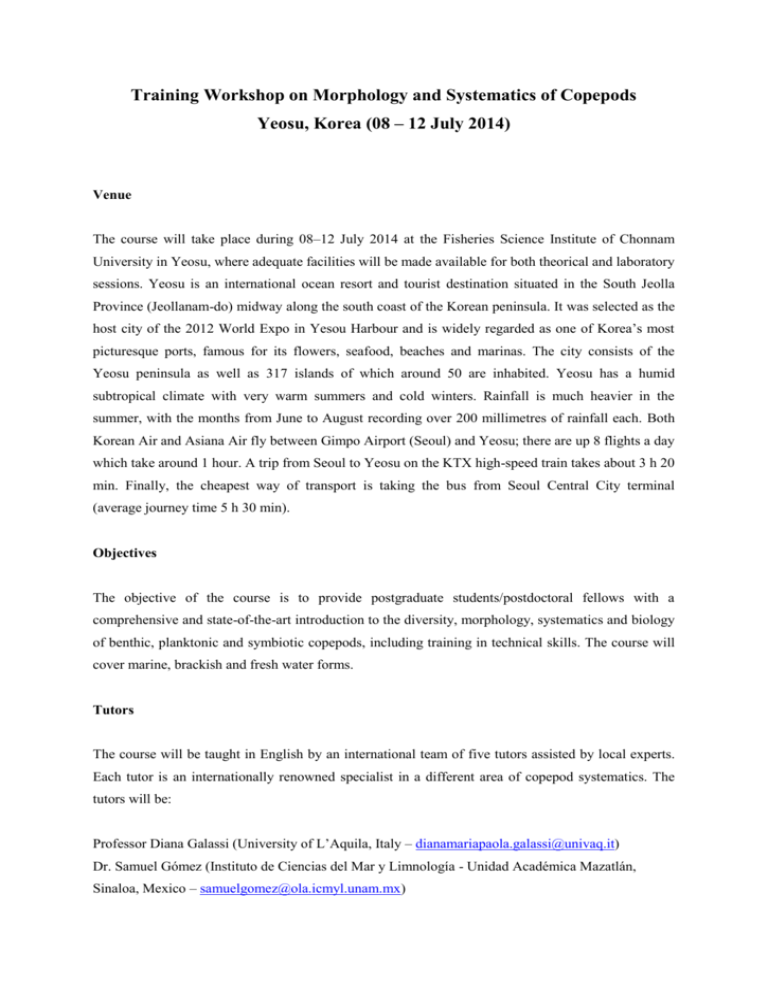
Training Workshop on Morphology and Systematics of Copepods Yeosu, Korea (08 – 12 July 2014) Venue The course will take place during 08–12 July 2014 at the Fisheries Science Institute of Chonnam University in Yeosu, where adequate facilities will be made available for both theorical and laboratory sessions. Yeosu is an international ocean resort and tourist destination situated in the South Jeolla Province (Jeollanam-do) midway along the south coast of the Korean peninsula. It was selected as the host city of the 2012 World Expo in Yesou Harbour and is widely regarded as one of Korea’s most picturesque ports, famous for its flowers, seafood, beaches and marinas. The city consists of the Yeosu peninsula as well as 317 islands of which around 50 are inhabited. Yeosu has a humid subtropical climate with very warm summers and cold winters. Rainfall is much heavier in the summer, with the months from June to August recording over 200 millimetres of rainfall each. Both Korean Air and Asiana Air fly between Gimpo Airport (Seoul) and Yeosu; there are up 8 flights a day which take around 1 hour. A trip from Seoul to Yeosu on the KTX high-speed train takes about 3 h 20 min. Finally, the cheapest way of transport is taking the bus from Seoul Central City terminal (average journey time 5 h 30 min). Objectives The objective of the course is to provide postgraduate students/postdoctoral fellows with a comprehensive and state-of-the-art introduction to the diversity, morphology, systematics and biology of benthic, planktonic and symbiotic copepods, including training in technical skills. The course will cover marine, brackish and fresh water forms. Tutors The course will be taught in English by an international team of five tutors assisted by local experts. Each tutor is an internationally renowned specialist in a different area of copepod systematics. The tutors will be: Professor Diana Galassi (University of L’Aquila, Italy – dianamariapaola.galassi@univaq.it) Dr. Samuel Gómez (Instituto de Ciencias del Mar y Limnología - Unidad Académica Mazatlán, Sinaloa, Mexico – samuelgomez@ola.icmyl.unam.mx) Professor Ju-shey Ho (California State University, Long Beach, U.S.A. – Jushey.Ho@csulb.edu) Professor Rony Huys (Natural History Museum, London, U.K. – r.huys@nhm.ac.uk) Professor Susumu Ohtsuka (Takehara Marine Science Station, Hiroshima University, Hiroshima, Japan – ohtsuka@hiroshima-u.ac.jp) Course Structure The course will last five days and will comprise a combination of lectures, laboratory-based practical sessions and informal, problem-solving discussions. Every tutor will be in attendance for all of them. Flexibility will be maintained to encourage the development of a intense group dynamic through interactions between highly motivated young researchers and established workers. Students will be asked to bring material with them that is of special interest or significance in their own work – particularly their problem species. A typical course day will consist of two 1–1.5-hour lectures alternated with practical sessions. Course Content 1) Introduction to Copepod Morphology, Ordinal Classification and Phylogeny (Tutor: Rony Huys) This session will provide a brief overview of copepod morphology and diversity and introduce participants to the impressive range of body forms and limb types across the Copepoda. Trainees will be introduced to the standardized terminology used in the description and identification of free-living and symbiotic copepods. An overview of the basic functional morphology of the reproductive, locomotory and feeding systems will be presented, and the importance of the various sensory structures encountered in copepods will be discussed. Finally, a brief synopsis of the current ordinal classification system will be presented, including some recent developments in our phylogenetic understanding of the group. 2) Taxonomic Techniques for the Study of Copepods (Tutor: Rony Huys) This lecture aims at students becoming familiar with the basic methods used in taxonomic studies of copepods. Topics will include procedures to extract material, fix, preserve, stain and sort samples. The presentation will also demonstrate how to produce adequate equipment to manipulate and dissect copepods and how to prepare temporary and semi-permanent slides, focusing especially on the clearing, staining, mounting and dissecting techniques. The information content of taxonomic illustrations will be discussed, and detailed information on preparing line drawings, inking techniques and image editing will be provided. 3) Diversity of Copepod Life Cycles (Tutor: Rony Huys) The ecological adaptability displayed by copepods is reflected in their tremendous morphological plasticity which makes it difficult to formulate a rigorous diagnosis of the subclass Copepoda that is both informative yet sufficiently comprehensive to cover the bizarre parasites as well as the freeliving forms. However, virtually all copepods have a stage in their life cycle, either the adult or one of the copepodid instars, exhibiting a cephalosome into which the maxilliped-bearing, first thoracic somite is incorporated and possessing at least two pairs of swimming legs, the members of which are linked by an intercoxal sclerite. The postembryonic development of copepods is divided into a naupliar phase and a copepodid phase. Primitively, each phase comprises six stages but larval development and life cycles are highly variable and can be significantly abbreviated (0–6 nauplii; 1–6 copepodids). Most copepods hatch at the (ortho)nauplius stage, a simple larval form. Occasionally the first stage in the life cycle is a metanauplius and some parasitic species are known to hatch as a copepodid. Typically, after six naupliar instars (often designated as NI, NII, NIII, etc.), the final nauplius stage molts into a copepodid stage, which resembles the adult but has a simple, unsegmented abdomen and only three pairs of thoracic limbs (maxillipeds and legs 1–2). Copepodid stages are often referred to as CoI, CoII, etc. (or CI, CII, etc.). In some parasitic groups a stage following the infective copepodid (or one of the copepodid stages) is called the chalimus; it differs from the copepodid in its possession of a frontal filament that aids in attachment to the host. There are significant changes in body size, shape and appendages in the molt from NVI to CoI, collectively known as metamorphosis. Intermolt stages are important for tracing the origin and homology of larval structures between naupliar and copepodid stages. Some parasitic copepods have an onychopodium or (transient) pupal stages in their life cycle. Participants will be introduced to the different larval types and the major differences between life cycles of free-living and symbiotic/parasitic copepods. 4) Marine Plankton: Systematics, Morphology and Feeding in Calanoid Copepods (Tutor: Susumu Ohtsuka) Participants will be introduced to the major calanoid families and the morphological characters used to distinguish them. The feeding strategies of calanoid copepods will be reviewed from morphological and evolutionary points of view. Calanoids can be classified into several types depending on the structure of their feeding appendages. The three different groups of particle-feeders differ primarily by the structure of the maxillae and maxillipeds, while carnivorous types are much more diversified in the oceanic regions. In the family Heterorhabdidae a venom-injection system is employed to catch prey animals. Such system could have evolved as a result of modifications of the feeding appendages and secretory glands of primitive particle-feeding heterorhabdids. Highly specialized carnivory is found also in the family Candaciidae whose members show a preference for gelatinous zooplankters. Detritivorous families, such as Scolecitrichidae and Phaennidae, bear two types of chemosensory setae on the maxillae and maxillipeds, i.e. worm-like and brush-like setae, which may have different functions. The deep-sea phaennid genus Cephalophanes exhibits a special preference for detrital matters originating from crustacean zooplankters. The elaborate eyes seem to play a role in the search for crustacean detritus, in concert with the sensory setae on the mouthparts. 5) Marine Benthos: Morphology and Systematics of Harpacticoida (Tutor: Samuel Gómez) Marine meiofauna is well known for its high abundance in relatively small samples, for its close relationship with the sediment (where most pollutants are found), for its lack of planktonic larvae, for its limited dispersal capacity, and for being a very important source of food and energy for crustaceans and (larval) fish. Despite its ecological role, studies about the ecology of meiofauna in some regions wordlwide are very scarce. The lack of a long-standing tradition in the study of meiofauna in these regions has led to a scarcity of researchers interested in the study of these communities, a genuine reflection of the difficulties faced when working with meiofauna. This is particularly symptomatic for the study of harpacticoid copepods, the most numerically important meiofaunal group after the nematodes. Analysis of temporal and spatial variation in copepod abundance and taxonomic composition has proven to be a reliable tool for the assessment of the health of marine and brackish ecosystems. However, the difficult taxonomy of harpacticoids has traditionally been viewed as a serious impediment to such assessments, particularly in regions where adequate taxonomic expertise and guidance are lacking. In this workshop, the importance, advantages and problems in the study of meiofauna will be presented, and students will be introduced to the taxonomy of harpacticoid copepods, its second most abundant component. 6) So Small, yet so Big: the What, Where and When of Copepod Radiation in Benthic Fresh Water (Tutor: Diana M. P. Galassi) Copepods colonized virtually all the freshwater habitats world-wide, from glaciers to deserts, and from planktonic to benthic habitats. Benthic freshwater habitats are the most diverse, offering different environmental conditions and allowing copepod species diversification. Surface fresh water is also connected with ground water, where frequently unique phylogenetic lineages are still preserved, having disappeared elsewhere. Lakes, ponds, rivers, ground water and related ecotones (GDEs) harbour high abundances and a species richness of benthic Cyclopoida and Harpacticoida, frequently outnumbering other meiofaunal groups. The order Gelyelloida is very rare and currently known from two groundwater sites in southern Europe and a hyporheic habitat in North America. Students will be introduced to (1) freshwater colonization pathways; (2) habitat preferences of the most common copepod families and genera, as exemplified by some flag species; (3) the Linnaean shortfall: morphological features discriminating families, genera and model species; (4) the role of freshwater copepods as indicators in water quality assessment and conservation issues. 7) Symbiotic Copepods Using Invertebrate Hosts: Diversity and Adaptation (Tutor: Rony Huys) Copepods utilise a spectacular variety of invertebrate metazoans as hosts, from sponges to urochordates. Relatively few species of copepods make use of host groups such as the Nemertea, Platyhelminthes, Bryozoa, Phoronida, Brachiopoda, Hemichordata and Sipuncula. However, they are very commonly associated with sponges, the entire range of cnidarian groups from the hard corals and sea anemones to the medusae and siphonophores, most echinoderm and molluscan groups, both solitary and colonial tunicates, and to a lesser extent, crustaceans and annelids (including the former phyla Echiura and Vestimentifera). The main families utilising particular invertebrate host phyla will be introduced and their usage of host microhabitats reviewed. The body form of copepods parasitic on marine invertebrates is astonishingly varied. Many retain the basic cyclopiform body but some of the most extreme examples of secondary reduction in body segmentation combined with the loss of paired limbs are found in copepods from invertebrate hosts. A surprising variety of species also possess a system of rootlets which penetrate host tissues. Students will be introduced to where to find symbiotic copepods, their adaptations to the parasitic mode of life, and the characters that are most useful in their identification. Key aspects of the biology of a selection of the most important taxa and methods of collecting and extracting copepods from their invertebrate hosts will also be summarised. 8) Symbiotic Copepods Using Marine Fish as Hosts: an Overview (Tutor: Ju-shey Ho) Marine fish of both elasmobranchs and actinopterygians are known to host 28 families of copepods comprising about 2,000 species. Participants of this workshop will be introduced to the systematics and morphology of these specialized copepods through a comparison of the various patterns of parasitism and parasitic adaptation. Copepods associated with fish hosts are known to exhibit three patterns of parasitism: ectoparasitism, mesoparasitism and endoparasitism. Adaptation to a parasitic mode of life is also reflected at different levels. Students will be introduced to three of them: (1) morphological adaptation, (2) developmental adaptation and (3) reproductive adaptation. 9) An Introduction to the Principles of Zoological Nomenclature (Tutor: Rony Huys) The International Code of Zoological Nomenclature (ICZN or The Code) is a widely accepted convention in zoology that rules the formal scientific naming of organisms treated as animals. The rules principally regulate (1) How names are correctly established in the frame of binominal nomenclature, (2) Which name must be used in case of name conflicts, and (3) How scientific literature must cite names. The rules and recommendations have one fundamental aim: to provide the maximum universality and continuity in the naming of all animals, except where taxonomic judgment dictates otherwise. The Code is meant to guide only the nomenclature of animals, while leaving zoologists freedom in classifying new taxa. Students will be introduced to the basic principles of zoological nomenclature including availability, validity, priority, synonymy and homonymy of taxomonic names. Cost The tuition fee is kept to a minimum and will be 50 USD for the entire course. Students attending the training workshop must pay for their own travel to Yeosu. The cost of this will be variable depending on the mode of transport. We assume that all participants will also be travelling to Seoul for the 12th International Conference on Copepoda, commencing on 14th July. Transport from the training course to the conference venue will be arranged on 13th July 2014 and a small charge may be made for a coach trip. Students must also pay for one week’s accommodation and meals. Precise costs are not yet available but we estimate that the cost of accommodation plus food will be approximately about 400 USD for 6 nights/days. More detailed costings will be provided in the next Monoculus newsletter. Organizers are requesting support to different agencies to offer partial scholarships to some students in order to cover accommodation or food expenses during the course. Selected students will be notified in due course. How to Apply A significant proportion of places will be reserved for trainees from Asian countries but applicants from outside these regions are also encouraged to apply. Applicants are expected to have a reasonable command of the English language. A questionnaire must be completed in order to apply for one of the limited places (20–25) in the course. The questionnaire can be found in the newsletter Monoculus, and it will be posted on the Conference website (http://www.12icoc.kr) and on the WAC website (http://www.monoculus.org/). It can also be obtained direct by emailing Rony Huys (r.huys@nhm.ac.uk). Students will be selected by the workshop organizer, in consultation with Prof. Wonchoel Lee and Prof. Jiang-Shiou Hwang. Please send or email your completed questionnaire to Rony Huys at the Department of Life Sciences, The Natural (r.huys@nhm.ac.uk). History Museum, Cromwell Road, London SW7 5BD, U.K. The deadline for receipt of applications is 15th May 2014. Special Offer to Workshop Participants The Ray Society has agreed to make two reference works on copepods available to workshop participants at a special concessionary price. Huys, R. & G.A. Boxshall (1991). Copepod Evolution. The Ray Society, London: 468 pp. Price for workshop participants: 25 USD (full retail price 90 USD). Boxshall, G.A. & S.H. Halsey (2004). An Introduction to Copepod Diversity. The Ray Society, London: xv + 966 pp [2 hardback volumes]. Price for workshop participants: 100 USD (full retail price 240 USD). Training Workshop on Morphology and Systematics of Copepods World Association of Copepodologists – Yeosu, Korea 2014 Questionnaire for Applicants Please expand the form as necessary to accommodate your answers – but keep to a maximum of two pages only please. 1. Name: 2. Nationality: 3. Address: 4. Contact details: Phone: E-mail: 5. What are your academic qualifications and in which year were they obtained? 6. What is your current position and/or project? 7. What experience do you already have of working with copepods, if any? 8. Why do you wish to attend this course and what do you expect from it? How will it current research? 9. What are the main areas of copepod systematics/biology that interest you? advance your 10. What samples/copepod groups will you bring to the workshop, if any? Please email or send this form to: Rony Huys (r.huys@nhm.ac.uk), Natural History Museum, Cromwell Road, London SW7 5BD, U.K. Deadline for receipt of applications: 15th May 2014
